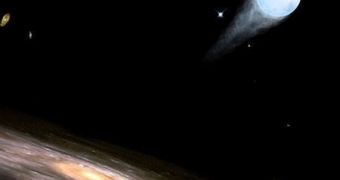A new astronomical theory could change the established knowledge about our own galaxy and its center. Supermassive black holes are currently thought to exist at the center of most galaxies, including Milky Way.
But what if for a second, invisible black holes were to exist at the center of our galaxy, besides the one already suspected to be there? The evidence to date is inconclusive, but according to some astronomers, there may be a simple way to detect its presence, at least in theory.
Currently, most astrophysicists believe there is a colossal black hole that weighs about 3.6 million times the Sun's mass. Observations of a cluster of young stars located just a fraction of a light year from the monstrous black hole seem to indicate the presence of a smaller, second one, that weighs 1000 to 10,000 Suns, lurking in the dark.
This cluster may have formed outside the Milky Way and could have migrated here and the black hole at its center could have been gravitationally drawn towards our galactic center. So far, this theory has been impossible to prove, but it could be done if scientists were to find a pair of so-called "hypervelocity" stars speeding away from the dangerous region.
Since December 2004, ten of these speed maniacs have been observed and the first one was caught streaking through space at 850 kilometers per second, a speed great enough to allow it to eventually escape the galaxy altogether.
The cause of this massive acceleration could be the interaction between three objects that are yet to be identified, although there are some theories about them. A classical one suggests that a pair of stars wanders too close to a single supermassive black hole, with one of them being captured and the others flung outwards at up to 4000 km/sec.
The second theory says that in fact, a single star approaches a pair of black holes and is ejected at high speed. If this is the case, then finding an example of hypervelocity stars speeding through space would be "definitive evidence" of the existence of two large black holes in the Milky Way.
This is what Youjun Lu, an astrophysicist at the University of California in Santa Cruz, US and colleagues, are hoping to observe in the near future, so that their theory could find a definitive answer.

 14 DAY TRIAL //
14 DAY TRIAL //